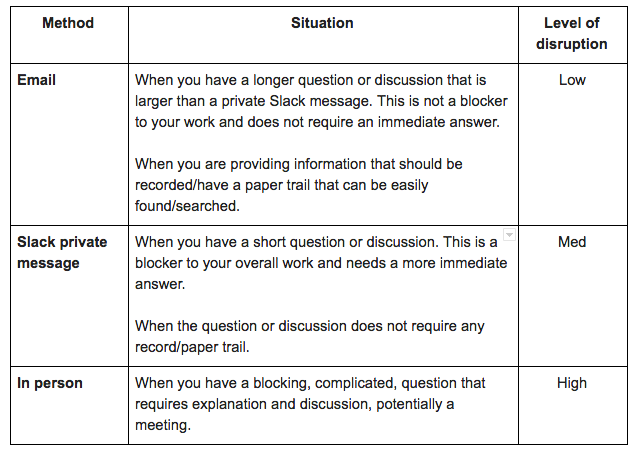How to Keep Your Team in the Zone
Learn some communication tactics to collaborate, but not pull one another out of the zone.

It’s 8:17 am on a snowy Wednesday. You have a fresh coffee steaming next to your keyboard, your headphones are on and you have started up your favourite Bon Iver album. You ended yesterday working on a finicky problem but, after sleeping on it, you think you have a good solution. You get cracking. Suddenly it is 11:42 am, and you realize your coffee is cold, you are starving, and you have to go to the bathroom. Also, you solved that problem like a pro.
That is what it feels like to be “in the zone”.
Staying in the zone means being able to maintain your concentration for long periods of time. It is vital to doing good work but can be hard to do.
Your brother keeps texting you about the newest Destiny expansion. Grace has messaged you on Slack to review her pull request. Candace has emailed you her blog post to read before she publishes it. Blair has popped into your office twice to get feedback on which restaurant to go to for the team lunch next week.
Between emails, meetings, phone calls, text messages, instant messages, and in-person chats, most days are a parade of interruptions. While many of the things that are being communicated in these interruptions are valid and necessary, the timing and delivery of HOW they are communicated can be optimized.
You can do this by getting your team in the habit of triaging their communication and collaboration needs before they pull someone out of the zone.
How to keep your team in the zone
Every time you are interrupted your brain has to:
- Shift to the interruption;
- Process it and make a decision about what to do about it;
- Potentially deal with it; and
- Spin up again to remember what you were doing before the interruption.
This is inefficient and takes a lot of mental energy if it happens over and over again throughout the day. You don’t want to discourage communication and collaboration between you and your team. BUT you also want everyone on your team, including yourself, to be able to stay in the zone for as long as possible.
Whenever your team needs to communicate with others they should use the least disruptive method possible, so you still ask questions and collaborate, but not pull one another out of the zone.
Think about this is by asking yourself:
- Is my work blocked if I don’t get an answer to this question immediately?
- Should this communication have a record/will I want to look up this discussion later?
- How disruptive are the means of communication I am using to the person I am reaching out to?
Set communication rules
The answer to these questions helps guide which means of communication they use. For example:

You want everyone to take moment to think about how important their question or discussion is and how to best approach others to keep everyone in the zone and doing great work. Depending on your business, you might have other ways people communicate, like text or phone, so you can create your own chart with suggestions for when you think these are most appropriate and how disruptive they are.
Other ways to keep everyone in the zone
Pay attention to body language
I have been guilty of swivelling my chair towards my husband, whose desk is next to mine, and asking him a question or making a comment about something while he has his headphones on.
He usually stops, takes a moment to pause his music and pulls off his headphones, before he asks me to repeat myself.
Headphones are a good indicator that someone is trying to concentrate and should be treated as an immediate stop point. I have had to get better at swivelling my chair, noticing that he has headphones on, and deciding if what I have to say or ask is worth interrupting him for. If it isn’t, I swivel my chair back, and:
- Write down my question to ask later and wait until there is an appropriate break in his concentration.
- Send him a message on Slack to ask him to let me know when he has a chance to chat.
If it is something I need to interrupt him for I gently get his attention and ask him, “Is now OK for me to interrupt you for 5 minutes?”.
This is about getting into the habit of paying attention to others and being more aware of how our behaviour impacts them.
Wait for a natural break
Another way to help each other stay in the zone is to wait until there is a natural break in someone's concentration before approaching them. Some examples include:

- When someone gets up to get more coffee.
- When they get back from going to the washroom.
- Right before or after lunch.
- When they get back from a meeting.
Pick times when they already appear out of the zone and before they get settled back in.
Interrupt with solutions, not problems
One of the things that I encourage our team to do, and I teach in my workshops, is to always bring their boss/manager/supervisor/colleague solutions, not problems. This is a powerful critical thinking habit that empowers the person asking the question/seeking solutions, and reduces the effort for the person being asked. It’s the difference between:
1. "What should I do about X?" - The person being asked has to come up with the options, consider them, and give an answer. The asker is avoiding ownership of X (the decision).
2. "I want to do Y about X. Sound good?" The person being asked is given a yes/no decision, which is more of a sanity check. The asker is taking ownership of X.
Consider your question or problem and think through the possible answers BEFORE you go ask. Consider things like:
- What are the possible scenarios or options?
- Which one do I think is the best one?
- What do I want to happen/the answer to be?
- Can I do any research to make the decision easier?
For example: You are researching which hotel to book for a conference you are attending with your manager, Sanjeet. You are unsure which hotel to select because the one you had originally talked about is full. You want to get Sanjeet’s opinion because your selection might impact the cost and travel time from the hotel to the conference. You go speak to Sanjeet:
- Interrupt with a problem: “The hotel I wanted to book is full. Where should we stay?”
- Interrupt with a solution: “The hotel I wanted to book is full. These are two alternate options. Option 1 is $20 more per night than we budgeted but closer to the conference so the cab ride will be very short. Option 2 is within the budget but quite far so the cab will be more expensive. I think we should go with Option 1 in the interest of saving time and not have to get up too early to get to the conference on time. I think the extra cost will be a wash. What do you think?”
In the first approach, Sanjeet has to go do a bunch of research and spend a lot of time getting enough details to make an informed decision. In the second approach, he can decide on option 1 or option 2, based on the information you provided.
By taking a bit more time to think through your question or problem, you will either come to your own conclusion/find an answer and not need to interrupt someone else or, you are able to speed up the conversation with a better-informed question.
Try it with your team
Download the ‘How to Keep Your Team in the Zone’ template. You can fill in your own rules for communication and then share them with your team.
Share
Ashley Janssen

Productivity consultant, writer, speaker, serial entrepreneur, chaos calmer, introvert, cat-lady. Lover of books, fitness, old fashioned’s, basketball, and video games.
Follow me on
Twitter
or
LinkedIn.
Hire me for
1 on 1 productivity consulting
or
speaking.
Related articles

Why Are You Productive For "Only" 5-6 Hours Each Day?

When You Do Things Matters


Comments ()